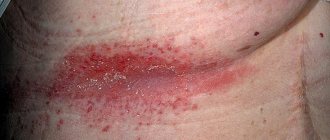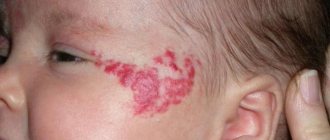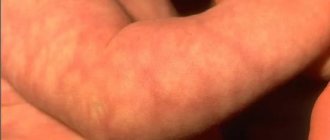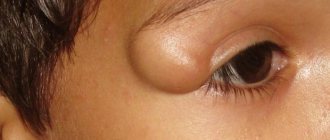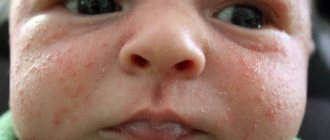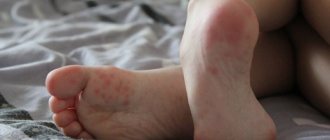Pediatrician
Sayfulina
Maryam Zakareevna
32 years of experience
Pediatrician of the highest category, member of the Union of Pediatricians of Russia
Make an appointment
Miliaria in children under one year of age and older is a fairly common skin lesion, which is a rash caused by severe sweating or poor care of the child’s delicate skin. It is important to understand that the baby’s thermoregulation processes are not yet perfectly established, and therefore the slightest negative factors can cause an undesirable reaction - parents should not be scared and think that this is a rare phenomenon. Almost all kids go through this.
However, you shouldn’t treat this problem negligently either: ordinary heat rash without treatment tends to become more complicated and worse, and in this case, longer and more complex treatment will be required - it’s better not to let it get to that point.
Symptoms
Symptoms of prickly heat in children include:
- The appearance of a characteristic rash on the neck, in the ear area, on the back of the head, along the hairline, armpits, in the upper chest, as well as on the back, in the groin folds and on the buttocks.
- Small rashes in the form of bubbles with transparent contents. In more complex cases, these are reddish nodules with an inflamed rim. The rash reacts to temperature, so it can decrease or increase depending on the environment.
- Weeping lesions - they occur when there is extensive damage to the skin.
- Pustules, swelling, redness of the skin and a putrid odor. This is not so much a symptom of prickly heat in children, but a signal that a bacterial or fungal infection has joined it.
- Soreness, itching and other unpleasant sensations that cause anxiety in the child make him capricious. This is not observed with ordinary heat rash, but if the condition is complicated, such negative factors will progress, simultaneously causing an increase in body temperature.
At any stage of heat rash in a child, even if it is very mild, it is necessary to consult a pediatrician. If complications arise, you should immediately consult a doctor - such issues are dealt with either by a pediatrician or a pediatric dermatologist.
When to Seek Medical Help
It is necessary to consult a specialist in these cases:
- the pain is severe and interferes with normal life;
- you have lost weight for no apparent reason;
- your hands go numb, you have difficulty swallowing and breathing;
- lymph nodes are enlarged for more than a week or in different parts of the body (for example, not only in the armpit, but also in the groin, neck);
- you have a fever and sweat a lot at night;
- you feel dizzy and your breathing is uneven.
Sometimes you want to take a painkiller to continue leading your normal life, but a pill will only relieve the symptoms. It is necessary to consult a doctor who will diagnose and prescribe treatment.
Causes
The main cause of heat rash in a child is overheating, and it is caused by various factors, including:
- Too warm, and synthetic clothes at that.
- Untimely changing of diapers, especially in hot weather or in a warm room.
- A minimal amount of air baths and infrequent bathing, due to which the skin is not cleansed and does not breathe.
- Using cosmetics that are too oily and thick on the skin, which does not allow heat to be released properly.
- Diseases associated with fever. Especially if parents also use warming treatment methods.
To overheating we will add such factors as allergies to various materials, friction and pressure of clothing, effect on irritated areas of feces and urine.
It may seem that the causes of heat rash in children are due solely to parental care errors, but this is absolutely not the case. There are children who themselves are prone to developing this condition. These are allergy sufferers, overweight children, children with various endocrine diseases (for example, diabetes). Also at risk are formula-fed children and premature newborns. When caring for such babies, you should be especially attentive to the condition of the skin and body.
Diagnostics
A pediatric dermatologist or pediatrician will examine the child and interview the parents, as well as a series of studies to rule out dermatitis, chickenpox, scarlet fever and many other diseases with similar symptoms. Most often, a visual examination is enough, but tests (scraping) may be required to help identify the causative agent of a secondary infection (if one is observed). A general and biochemical blood test is often done, as well as an analysis of the contents of the vesicles - it all depends on the recommendations of the attending physician.
Treatment
Usually, treatment of prickly heat in a child is carried out comprehensively and includes the following points:
- Maintaining optimal temperature in the house - no more than 20-22 degrees Celsius. The same goes for humidity, which needs to be monitored - 50-70%.
- The right choice of clothes. It must be appropriate for the temperature and not be synthetic or too dense.
- Regular hygiene procedures - washing, bathing using gentle cosmetics designed specifically for children's delicate skin.
- Regular diaper changes. Your baby's skin should always be clean and dry.
- Use of medications and other means prescribed by a doctor. Sometimes decoctions of medicinal herbs are allowed, but only when the doctor allows it. For the rest, specially selected ointments, powders and other medications are used. In difficult cases, antifungal drugs and antibiotic-based ointments can be used - but parents should not purchase such products on their own.
As a rule, when prickly heat appears in a child, the prognosis is good. After establishing hygiene procedures, the problem disappears quite quickly. If the baby’s immunity is severely weakened, and a dangerous infection develops against the background of prickly heat, there is a risk of complications. In this case, the treatment will be longer and more complex, and in exceptional cases it will require hospitalization of the child.
If your baby exhibits symptoms of infant heat rash, do not wait until complications begin - be sure to contact pediatricians or dermatologists at Meditsina JSC - get examined by a doctor, get an accurate diagnosis and an effective treatment plan.
What you should never do if you have heat rash in a child
Before visiting specialists, many parents try to help their child on their own and use various tips from the Internet. This should not be done under any circumstances. We have compiled a short list of what is prohibited:
- Squeeze and open the blisters on the baby’s skin.
- Cover inflammations and blisters with iodine or brilliant green, as well as other aggressive agents.
- Moisturize the skin with any available means. Heavy moisturizing creams are often used, which in this case are strictly contraindicated.
- Dry wet areas with rough materials or sudden movements. If it is necessary to remove moisture, this is done with very clean, soft and highly absorbent material - with extremely careful and smooth movements.
But it is best to immediately visit a doctor and get detailed advice about what you can and cannot do.
Atopic dermatitis in children
Unfortunately, many children experience the first manifestations of skin allergies at an early age. It's not always possible to understand why. It seems that the parents are doing everything right: they don’t let them eat “chemicals”, they take care of the skin, they bathe the baby, they introduce complementary foods correctly, but the child has itching and rashes.
So what is “atopic dermatitis” or, as it is often called in older children, “neurodermatitis”. How to defeat him?
What is atopic dermatitis? Atopic dermatitis is a chronic inflammatory skin disease caused by various factors, in which the child is bothered by itching.
Typically, atopic dermatitis begins in early childhood, can continue or recur in adulthood, and significantly affects the quality of life of the patient and his family members.
Most often, if a child has allergies, then someone in the family has allergies. If both parents suffer from allergies, then, unfortunately, in 82% of cases the child will also have atopic dermatitis.
What happens in the skin during atopic dermatitis: With atopic dermatitis, immune inflammation occurs in the child’s skin, which is accompanied by an increase in its sensitivity to external and internal factors affecting the skin.
Also, with this disease, the protective barrier of the skin is disrupted, which leads to the penetration of allergens through the skin. The amount of fats (lipids) in the skin decreases, which leads to dry skin and itching.
How do doctors diagnose Atopic Dermatitis?
First of all, when examining the child and asking the parents in detail, and only then, based on the results of an allergological examination.
Unfortunately, objective diagnostic tests that can confirm the diagnosis 100% do not currently exist.
Signs of atopic dermatitis:
- Itchy skin
- Typical rashes and their location:
- children of the first two years of life: red spots, spots, weeping skin, most often on the face and less often on the legs and thighs. - older children (2-12 years): severe dry skin, thickening of skin folds, scratching on symmetrical areas of the skin, more often on the flexor surfaces of the limbs, for example, in the elbows or under the knees.
- Early age of onset of allergic rash, most often before one year
- Usually, someone in the family has or has had allergies
- Once allergic rashes appear, they do not go away for a long time
There is also such a non-obvious symptom as “white dermographism”. If you run your finger over the skin of a child’s abdomen, after a while white stripes will appear in the place where the finger touched the child’s skin, which do not immediately disappear.
And yet, what tests can be taken to understand the causes of allergies in a child?
- Clinical blood test
- Skin tests with standardized allergens (they are also called prick tests, skin prick tests). Skin testing is carried out by an allergist when there is no exacerbation of atopic dermatitis in a child, that is, there are no skin rashes and the child is not itching. If a child is taking antihistamines, they must be discontinued at least three days before the test, otherwise the result may be unreliable.
- It is recommended to determine allergen-specific immunoglobulin E antibodies (IgE antibodies) in blood serum. They are also called “allergens”. Using them, you can understand what foods or household factors your child is allergic to, but, unfortunately, they are not always 100% accurate.
What are the manifestations of atopic dermatitis in children like:
There are many skin diseases that allergy rashes in a child may resemble. Here are some of them:
- scabies
- seborrheic dermatitis
- allergic contact dermatitis
- ichthyosis
- psoriasis
All diseases are different and are treated differently.
Therefore, in addition to an allergist, children with regular manifestations of skin allergies should be consulted by a dermatologist.
Treatment There is an opinion that following a low-allergen diet will clear the skin and the itching will go away. This is not entirely true. Treatment must be comprehensive.
There are several areas of treatment and they are all important:
1. Elimination diet 2. Hypoallergenic regimen 3. Proper skin care 4. Taking antihistamines and antibacterial drugs 5. Psychotherapy
Elimination (hypoallergenic) diet
Of course, it is important to identify what foods your child is allergic to. And then, by removing these foods from the diet, you can reduce the manifestations of atopic dermatitis. Please note that it is precisely to reduce, and not to stop altogether, the manifestations of allergies, since a low-allergen diet is important not on its own, but always in combination with proper skin care, which we will discuss below.
But identifying what you are allergic to is often very difficult. Both from laboratory tests and from observing what foods a child eats, it can be difficult to understand what the child is allergic to. In such cases, a so-called hypoallergenic diet is recommended. Foods that can cause an exacerbation of allergies in most people with allergies are excluded from the diet.
Not recommended for use:
- Citrus
- Seafood
- Rich broths
- Processed meat products
- Mayonnaise, vinegar, mustard
- Radish, horseradish, radish
- Spices
- Whole milk
- Honey
- Strawberry
- A pineapple,
- Melon,
- Sweet carbonated drinks,
- Nuts
Hypoallergenic mode
Reducing a child’s contact with an allergen can hardly be overestimated, which is why it is so important to follow household rules. In most cases, it is impossible to completely eliminate contact with the allergen, but as a result of following the recommendations, contact with it is significantly limited, which means that the course of the disease is alleviated and the need for medications is reduced.
Here's what you need to do - the information below is presented by the Ministry of Health of the Russian Federation, that is, it is official and truthful:
1. regularly wash bedding (1-2 times a week) at a temperature above 56°C to kill mites (washing with cold water reduces mite allergens by 90%, and washing with hot water destroys mites) 2. wash pillows and blankets with hot water more than 56°C and mattress covers (covers) made of mite-proof fabric 3. remember that good ventilation of the home reduces humidity, reducing the humidity in the house to 40% is important for controlling the number of mites and fungi
Additionally:
1. use vacuum cleaners to clean your home (preferably with a HEPA filter) 2. use special napkins to remove dust 3. to ensure better conditions for cleaning, it is advisable to replace carpets and rugs with linoleum or parquet 4. it is better to change curtains in the bedroom with washable blinds 5. replace fabric-covered furniture with leather or vinyl 6. remove soft toys from the bedroom; if necessary, they can be washed in hot water (over 56°C) or frozen in the freezer of a home refrigerator to kill ticks 7. considering, that house dust mites are sensitive to direct exposure to sunlight, you can dry mattresses, carpets, rugs in the sun for at least 3 hours (taking into account regional characteristics) 8. In addition, special means can be used to destroy house dust mites - cleaning wipes, aerosols, anti-mite bedding, sprays, washing powders, anti-mite carpet cleaners (based on benzyl benzoate - acaricides), anti-mite cleaners for cleaning vacuum cleaners, etc. 9. To achieve the desired result, an integrated approach is important, since most elimination measures applied individually turn out to be unprofitable and ineffective 10. Important! It must be remembered that allergen-free animals do not exist. It is better to take radical measures - part with pets and not get new ones. After removing the animal from the apartment, it is necessary to carry out repeated thorough cleaning of the room to completely remove traces of saliva, excrement, dander, and animal hair. Cat allergens persist in the living room even after the animal is removed for a long time (about 6 months)
Besides:
1. Carpets, mattresses and coverings should be subjected to regular vacuum cleaning; change clothes when leaving home if there was contact with a pet 2. do not visit the circus, zoo and houses where there are animals 3. do not wear clothes made of wool or animal fur
It is also necessary:
1. limit as much as possible contact with environmental factors that cause exacerbation of the disease 2. ensure optimal room humidity (40%) 3. maintain a comfortable air temperature 4. use indoor air conditioning in hot weather 5. do not use synthetic fabrics or wool clothing , preference is for cotton fabrics 6. ensure a calm environment at school and at home 7. cut your nails short 8. during an exacerbation, sleep in cotton socks and gloves 9. do not prohibit bathing! do not use hot water for showers and/or baths; water procedures should be short-term (5-10 minutes) using warm water (32-35°C) 10. use special skin care products for atopic dermatitis (so-called emollients) constantly, even when the skin is “good” 11. for when washing, use liquid rather than powder detergents 12. minimize contact with allergens that cause aggravation of the disease, as well as irritating substances 13. in sunny weather, use sunscreens that do not cause contact irritation of the skin 14. after swimming in the pool, you must take a shower and apply moisturizer 15. completely follow the doctor’s instructions
Not worth it:
1. use alcohol-containing hygiene products 2. use products with antimicrobial components without the recommendation of the attending physician 3. participate in sports, as this causes intense sweating and is accompanied by close contact of the skin with clothing 4. take water procedures too often 5. intensively while washing rub the skin and use tools for washing that are harsher than a terry cloth washcloth
To achieve the desired result, an integrated approach is important, since most elimination measures applied individually turn out to be unprofitable and ineffective.
Proper skin care
The goal of proper skin care is to relieve itching by restoring the water-lipid layer and barrier function of the skin.
1. Local glucocorticosteroids
In case of exacerbation of atopic dermatitis, to quickly alleviate the child’s condition, it is recommended to apply so-called local glucocorticosteroids to the areas of allergy.
2. Calcineurin inhibitors These drugs are recommended to be applied to the skin of a child when atopic dermatitis often worsens, the exacerbations do not subside for a long time, and the child is constantly bothered by itching and irritation of the skin. These drugs are prescribed only by a doctor.
3. Moisturizers and emollients
They are called "emollients". They do not contain hormones or parabens. These products nourish and moisturize the skin, reduce dryness and reduce itching.
It is important to apply them to the skin daily, at least twice a day, even when the skin is smooth, without allergies and without itching.
Emollients are selected individually by parents, on the recommendation of a doctor, so that the child finds their texture pleasant; for some children, it is important that the emollient does not have any odor.
To cleanse the skin, it is advisable to use daily short cool baths (10 minutes) with a soft detergent base with pH 5.5, which does not contain alkali. When cleansing the skin, do not rub it. After bathing, it is recommended to only blot the surface of the skin without wiping it dry.
And it is more effective to use bathing products of the same brand as the emollient. Then they reinforce each other.
Taking antihistamines and antibacterial drugs
1. Antihistamines, or as they are also called, antiallergic drugs, reduce itching. They are prescribed by a doctor.
2. Taking antibacterial drugs Staphylococcus aureus (S. aureus) often grows on the skin of patients with atopic dermatitis, which increases the manifestations of allergies. Therefore, sometimes it is necessary to use antibacterial drugs in the form of cream/ointment or in the form of syrup, which the child takes orally.
Psychotherapy
Working with a psychotherapist and a psychologist is also important. These specialists teach the child techniques for relaxation, stress relief and behavior modification. But these methods are only suitable for older children.
What's next?
Atopic dermatitis has a wavy, relapsing course: unfortunately, 60% return throughout life. Therefore, a hypoallergenic lifestyle, proper skin care (constant use of emollients), and a hypoallergenic diet are important throughout the life of a child with atopic dermatitis.
Atopic dermatitis is a chronic skin disease that significantly reduces a child’s quality of life due to constant itching and dry skin, but it can be managed thanks to the achievements of modern medicine. It is important to find a doctor you trust and follow his recommendations.

